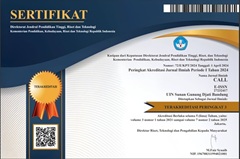THE CONNOTATIVE MEANING OF CORONAVIRUS IMPACT EXPRESSIONS IN TEMPO ENGLISH MAGAZINE
DOI:
https://doi.org/10.15575/call.v3i1.12489Abstract
This research focuses on analyzing coronavirus impact expressions in Tempo English magazine by using theory of connotative meaning from Leech as the grand theory and from Hook as the supporting theory. The focus is on two kinds of connotative meaning, namely, positive and negative connotative meaning. The objectivities of this research are to find out and to explain the use of negative and connotative meaning. The research is qualitative by which helps the researcher to describe the data being studied. In analyzing qualitative data, there are various kinds of methods, including qualitative content analysis. The use of a qualitative content analysis in this research is to know, to describe, and to analyze the use of connotative meaning applied in Tempo English magazine, April 14, 2020 edition. The result of this research is that Tempo English magazine uses many connotative meaning of coronavirus impact expressions. There are 15 expressions as negative connotative meaning and 12 expressions as positive connotative meaning. The findings indicates that the use negative connotative meaning of coronavirus impact expressions in Tempo English magazine are associated with threats in economy sector and associated with inappropriate government policies in an effort to prevent the spread of covid-19 as well as the impact of pandemic in many sectors. Besides, the use positive connotative meaning of coronavirus impact expressions in Tempo English magazine are associated with solutions to avoid spread of Covid-19 as well as solutions to avoid the impact of pandemic, and associated with the government’s responsibility and seriousness in dealing with preventing the spread of coronavirus as well as in dealing with the impact of coronavirus.
Â
Keywords: semantics; connotative meaning; coronavirus impact
References
Berg, B. L. (2001). Qualitative Research Methods for the Social Sciences. Boston: Allyn & Bacon.
Bogdan, R. C., & Biklen, S. K. (2006). Qualitative Research for Education: An Introduction to Theory and Methods (5th ed.). Boston, Massachusetts: Pearson.
Budd, R. W., Thorp, R. K., & Donohew, L. (1967). Content Analysis of Communication. New York: Collier-Mac.
Chaer, A. (2009). Pengantar semantik Bahasa Indonesia. Jakarta: Rineka Cipta.
Creswell, J. W. (2014). Research Design: Qualitative, Quantitative, and Mixed Methods Approaches (4th ed.). Thousand Oaks: Sage Publications, Inc.
Finch, G. (2003). How to Study Linguistics: A Guide to Understanding Language (2nd ed.) . New York: Palgrave Macmillan.
Hornby, A. S. (2010). Oxford Advanced Leaner's Dictionary: International Student's Edition. Oxford: Oxford University Press.
Kreidler, C. W. (1998). Introduction English Semantics. New York: Routledge.
Leech, G. (1981). Semantics Study of meaning (2nd ed.). London: Penguin Books.
Lyons, J. (1995). Introduction to Theoretical Linguistics. London: Cambridge University Press.
Pateda, M. (2001). Semantik Leksikal. Jakarta: Rineka Cipta.
Riemer, N. (2010). Introduction Semantics. New York: Cambridge University Press.
Saeed, J. I. (2016). Semantics (4th ed.). Chichester: Wiley Blackwell.
Schreier, M. (2012). Qualitative Content Analysis in Practice. Thousand Oaks: Sage Publication.
Shannon, S. E., & Hsieh, H.-F. (2005). Three Approaches to Qualitative Content Analysis. Qualittaive Health Research, XV(9), 1277-1288.
Steele, J. (2005). War within: The Story of Tempo, an Independent Magazine in Soeharto’s Indonesia . Jakarta: Equinox Publishing.
Widarso, W. (2000). Bahasa Inggris: Dialek, Ragam, Jargon, Slang, Blends, Clipped Words. Yogyakarta: Kanisius.
Zhang, Y., & Wildemuth, B. M. (2005). Qualitative Analysis of Content. Human Brain Mapping, 30(7), 2197-2206.
Downloads
Published
Issue
Section
Citation Check
License
Authors who publish in CALL agree to the following terms:
- Authors retain copyright and grant the journal right of first publication with the work simultaneously licensed under Attribution-ShareAlike 4.0 International (CC BY-SA 4.0) License that allows others to share the work with an acknowledgment of the work's authorship and initial publication in this journal.
- Authors are able to enter into separate, additional contractual arrangements for the non-exclusive distribution of the journal's published version of the work (e.g., post it to an institutional repository or publish it in a book), with an acknowledgment of its initial publication in this journal.
- Authors are permitted and encouraged to post their work online (e.g., in institutional repositories or on their website) prior to and during the submission process, as it can lead to productive exchanges, as well as earlier and greater citation of published work (See The Effect of Open Access).




